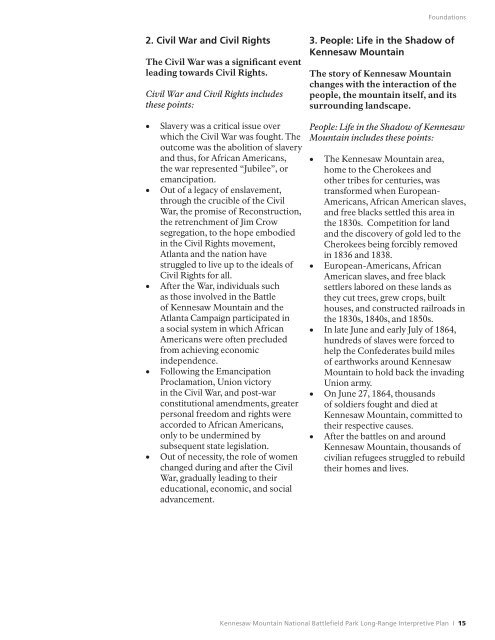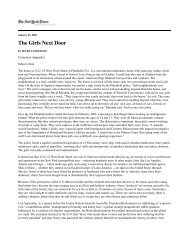Kennesaw Mountain National Battlefield Park - Kennesaw State ...
Kennesaw Mountain National Battlefield Park - Kennesaw State ...
Kennesaw Mountain National Battlefield Park - Kennesaw State ...
You also want an ePaper? Increase the reach of your titles
YUMPU automatically turns print PDFs into web optimized ePapers that Google loves.
2. Civil War and Civil Rights<br />
The Civil War was a signifi cant event<br />
leading towards Civil Rights.<br />
Civil War and Civil Rights includes<br />
these points:<br />
Slavery was a critical issue over<br />
which the Civil War was fought. The<br />
outcome was the abolition of slavery<br />
and thus, for African Americans,<br />
the war represented “Jubilee”, or<br />
emancipation.<br />
Out of a legacy of enslavement,<br />
through the crucible of the Civil<br />
War, the promise of Reconstruction,<br />
the retrenchment of Jim Crow<br />
segregation, to the hope embodied<br />
in the Civil Rights movement,<br />
Atlanta and the nation have<br />
struggled to live up to the ideals of<br />
Civil Rights for all.<br />
After the War, individuals such<br />
as those involved in the Battle<br />
of <strong>Kennesaw</strong> <strong>Mountain</strong> and the<br />
Atlanta Campaign participated in<br />
a social system in which African<br />
Americans were often precluded<br />
from achieving economic<br />
independence.<br />
Following the Emancipation<br />
Proclamation, Union victory<br />
in the Civil War, and post-war<br />
constitutional amendments, greater<br />
personal freedom and rights were<br />
accorded to African Americans,<br />
only to be undermined by<br />
subsequent state legislation.<br />
Out of necessity, the role of women<br />
changed during and after the Civil<br />
War, gradually leading to their<br />
educational, economic, and social<br />
advancement.<br />
Foundations<br />
3. People: Life in the Shadow of<br />
<strong>Kennesaw</strong> <strong>Mountain</strong><br />
The story of <strong>Kennesaw</strong> <strong>Mountain</strong><br />
changes with the interaction of the<br />
people, the mountain itself, and its<br />
surrounding landscape.<br />
People: Life in the Shadow of <strong>Kennesaw</strong><br />
<strong>Mountain</strong> includes these points:<br />
The <strong>Kennesaw</strong> <strong>Mountain</strong> area,<br />
home to the Cherokees and<br />
other tribes for centuries, was<br />
transformed when European-<br />
Americans, African American slaves,<br />
and free blacks settled this area in<br />
the 1830s. Competition for land<br />
and the discovery of gold led to the<br />
Cherokees being forcibly removed<br />
in 1836 and 1838.<br />
European-Americans, African<br />
American slaves, and free black<br />
settlers labored on these lands as<br />
they cut trees, grew crops, built<br />
houses, and constructed railroads in<br />
the 1830s, 1840s, and 1850s.<br />
In late June and early July of 1864,<br />
hundreds of slaves were forced to<br />
help the Confederates build miles<br />
of earthworks around <strong>Kennesaw</strong><br />
<strong>Mountain</strong> to hold back the invading<br />
Union army.<br />
On June 27, 1864, thousands<br />
of soldiers fought and died at<br />
<strong>Kennesaw</strong> <strong>Mountain</strong>, committed to<br />
their respective causes.<br />
After the battles on and around<br />
<strong>Kennesaw</strong> <strong>Mountain</strong>, thousands of<br />
civilian refugees struggled to rebuild<br />
their homes and lives.<br />
<strong>Kennesaw</strong> <strong>Mountain</strong> <strong>National</strong> Battlefi eld <strong>Park</strong> Long-Range Interpretive Plan I<br />
15



